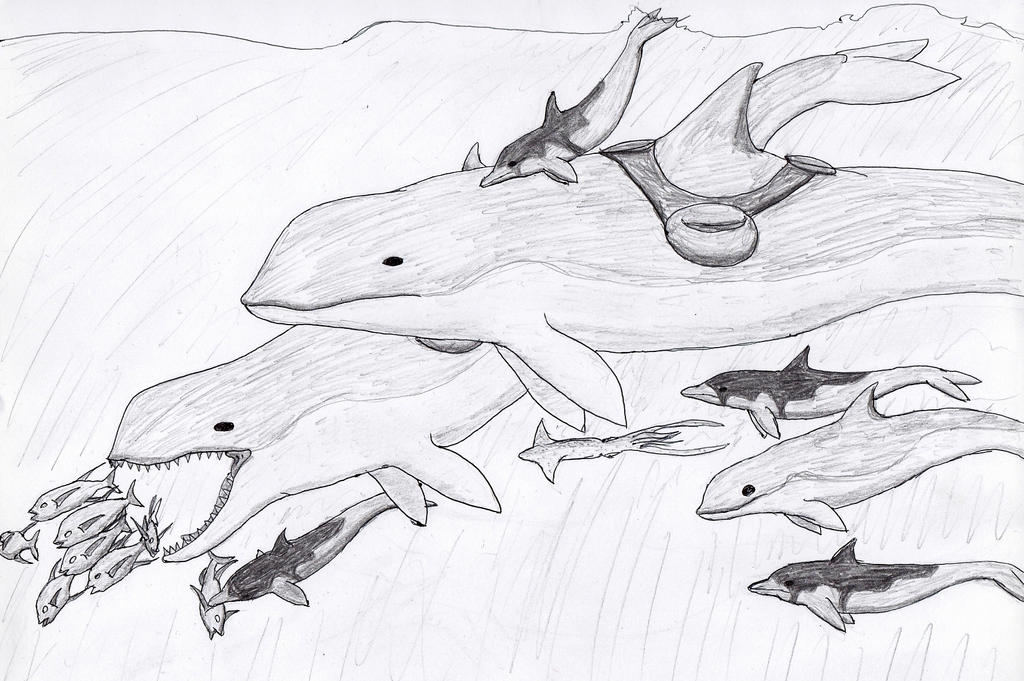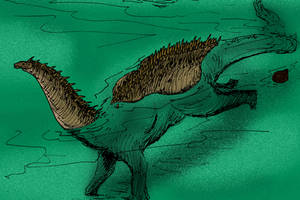Deviation Actions
Description
A slight follow up to an early piece, we return to the world 12 million years hence. The biosphere has nearly finished recovering from the Anthropocene mass extinction, South America has rifted away from North America, a mountain range is connecting the Indonesian Islands, a sea now penetrates deeply into East Africa, and a sea has disappeared as Africa smashed into Europe. The ocean’s life assemblage has notably changed; there are no baleen whales, nor are there pinnipeds. Instead, the two main tetrapodean groups in the ocean are toothed cetaceans—a group of old—and otters—a comparatively new kid on the block. While the otters themselves are important enough to warrant their own piece, for now we’ll focus purely on one representative of the cetaceans. By 12 million years hence, a sapient cetacean had evolved, utilizing a prehensile penis/clitoris to fabricate some tools. They will be known as the Qucha.
For the sake of brevity, their evolutionary history won’t be delved into very much [1]. While they started as hunter gatherers hunting in the sea grass ecosystems of the Panama Strait, they have slowly spread out into different environments. While hunting gathering is still used, different foraging tactics are necessary to survive in some radically different ecosystems—and none are as extreme as the open ocean. The pelagic realm is home to beasts of unmatched speed and endurance, where almost every prey item can bolt out of all but the most elaborate traps, and where predators can run down even the most athletic Qucha. So in order to survive in such an environment, the Qucha acquired a mutual relationship with a distant relative.
The Koloha is just the perfect relative. The Koloha are predators with exceptionally high endurance who hunt a wide variety of prey: from gulping schools of fish and squid, to devouring sharks and other cetaceans, they are near the apex predators of their environment. Indeed, all their sole fear is the massive dragon shark, a 50-foot requiem shark that cruises like its ancient tiger shark relative. While not quite as intelligent as the Qucha, the Koloha are intelligent enough to make decisions on their own right. While at first they were adverse towards the Qucha, they began tolerating their presence as the Qucha pods proved to be mostly harmless, indeed they were hugely useful. The Qucha’s excellent planning lead to a higher hunting rate for both Koloha and Qucha. Furthermore, the Qucha proved to be extremely effective protectors, aggressively swarming attacking dragon sharks and adeptly striking at the fish’s more sensitive areas. Indeed, Koloha who swam with Qucha have significantly increased odds of survival.
Over time, the relationship formed to make diverse cultures of Qucha who swam with Koloha, using their slipstreams to cruise the oceans and hunting prey with far greater efficiency. Milk, teeth, and bones (when possible) are utilized to the Qucha’s advantage, and they thrive in an ecosystem that would have been considered extremely foreign. But perhaps most interestingly, the pelagic Qucha still retain contact with other Qucha populations. If one was to ask a Qucha who lives in the reefs, they would likely have only poor things to say about their nomadic compatriots; at best, the pelagic Qucha would be considered uncultured weirdos, at worst, they would be considered bloodthirsty barbarians. Neither viewpoint is fair however, because the nomadic Qucha serve as a surefire way to allow for the dispersal of technology and ideas to the many different reef cultures, who are frequently separated by hundreds of miles. Sometimes though, the pelagic cultures are known to attack reef cultures, using their massive Koloha compatriots as beasts of war. Indeed, the image of a 40-foot whale barreling toward a reef garden is sure to strike fear into the hearts of any Qucha living there.
[1] For more information on their origins, click this link: whachamacallit1.deviantart.com….
Elephants have prehensile peens that can throw a man BTW



































